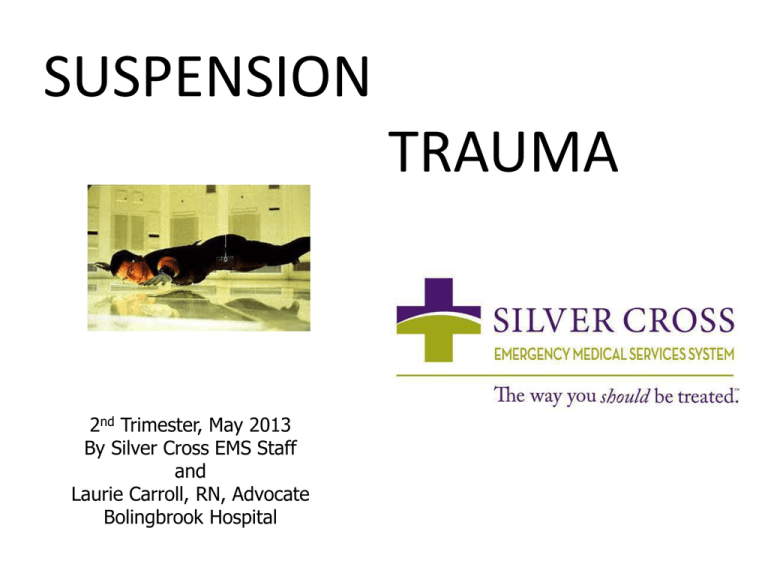
SUSPENSION
TRAUMA
2nd Trimester, May 2013
By Silver Cross EMS Staff
and
Laurie Carroll, RN, Advocate
Bolingbrook Hospital
Our Agenda Today
• System announcements
– Happy EMS week, drug shortages, other info
• Suspension Trauma SMO
– Thank you Region VII for suspension trauma info
•
•
•
•
Crush injuries
ALS strip o’ the month: hyperkalemia
Drug o’ the month: glucose
Questions?
Glossary Terms
•
Fall Arrest Systems: A series of equipment components designed to stop the fall of individuals
elevated in the air. It is an OSHA requirement when workers are exposed to vertical drops of 6 feet
or more.
•
Orthostatic Hypotension: In suspension trauma, this refers to the pooling of blood in leg veins that
occurs when individuals caught in harnesses, confined spaces, ropes, etc., are forced to hang
vertically with legs relaxed.
•
Reflow Syndrome: The return of pooled, hypoxic blood and its metabolic byproducts from the
extremities to the heart.
•
Rescue Death: When related to suspension trauma, this type of death occurs in patients who
appear physiologically stable during the rescue and extrication but suddenly die after being freed.
•
Suspension Trauma: Injuries sustained from being immobilized in a vertical position when the legs
are relaxed. Injuries include hypoxia; syncope; hypoxemia; acidosis; ventricular fibrillation;
myocardial infarction; damage to the liver, kidneys and brain; and possibly death.
•
Suspension Syndrome: The condition in which a suspended person becomes unconscious due to
orthostasis without traumatic injury.
•
Suspension Trauma Syndrome: Previous terminology for suspension syndrome.
•
Syncope: A sudden loss of consciousness due to a rapid drop in blood pressure.
Suspension trauma
• Occurs when the human body is held upright
without any movement for a period of time.
• If the person is strapped into a harness or tied
to an upright object they will eventually suffer
syncopal episodes.
– If pt faints but remains vertical, risks death due to
brain not receiving the oxygen it requires.
Introduction
• Suspension Trauma
– The medical effects of immobilization in a vertical position
– Medical term is ‘Orthostatic Incompetence’
• The effects are nothing new
– Crucifixion is death from suspension trauma
• It presents an immediate threat of death to anyone immobilized in a vertical
position
– Hanging still in an industrial, theatrical or sport harness
– Stretcher patients, performers, stuntmen, confined space workers
• The onset and progress are rapid and unpredictable
• All those ‘working at height’ must be trained in how to recognize, manage and
prevent suspension trauma
Deaths from suspension
• Since the early 1970’s when people started
wearing harnesses for climbing, caving and in
industry, about 100 people have died directly
from suspension trauma.
• Several were stretcher patients, people
training with rescue teams, theatrical
performers.
• Almost all were healthy and uninjured prior to
the suspension.
Immobile is important!
• Suspension trauma can only affect someone who is immobile
– specifically not using their leg muscles to any great extent
• It does not normally affect people who wear a harness who
are:
– Actively moving about (climbing, caving, etc)
– Suspended for only a minute or two (parachutists)
• The danger is when someone is unable to move FOR AS LITTLE
AS 4 MINUTES!
Who may be at risk?
• The ‘classic group’ are people who wear harnesses
– Sport climbers, cavers, parachutists, etc
– Industrial workers, high angle work, windmill work
• Local “windmill farms” risky areas for suspension trauma
– Confined space workers lowered using a harness and winch
– Theatrical and circus performers, stuntmen and artists
• There are other ways to be ‘immobilized’
– Personal pursuits involving bondage or confinement
– Becoming stuck in a confined space
So what happens?
• General feelings of unease
– Dizzy, sweaty and other signs of shock
– Increased pulse and breathing rates
• Then a sudden drop in pulse & BP
• Instant loss of consciousness
• If not rescued, death is certain
– From suffocation due to a closed airway,
or from lack of blood flow and oxygen to
the brain.
Excess pressure here
can cut blood flow to
the legs
Shock
• Early effects are from distributative shock, and
develop within a few minutes.
• Fainting process is instant
– In a test, medical staff asked fit/uninjured students to hang
in a harness and count upwards, paying them money if
they counted highest and remembered the number.
– They fainted between one number and the next
– Of 50 volunteers only two remembered a number, and
both were wrong.
A little biology…
• Humans are not designed to stand upright
– Our circulatory system was built for life on all fours
– Volume of blood vessels is much greater than that of the blood
• So, when we stand upright we have a problem
– Gravity pulls your blood into your legs
– Your heart is a positive-pressure pump – it cannot suck!
– The only way to get the blood back out of the legs is to pump it
using another method.
Muscular pumps
• Veins in legs intertwined within skeletal muscles.
• When you move your legs, these muscles squeeze the veins,
pushing the blood out of the way
• We have one-way valves in these veins, so each squeeze can
pump the blood a short distance towards the heart
• Providing you are walking around, this process makes a ‘heart
in each leg’ – and it’s very effective!
– Try it – take your socks off and stand still – look at your feet
and you’ll see the veins all standing out and the skin red.
– Now walk around in a little circle and look again – the veins
are empty and flat, and the skin goes pale. Pumping in
action!
But what if we’re not pumping?
• If the muscles are not pumping the blood
upwards, it pools in your legs
– You can ‘lose’ several pints and go into shock
• Your brain tries ‘shock’ for a while, but it
doesn’t help – blood is still stuck in your legs.
• After a few minutes, it goes for the last-ditch
method
If I faint, I fall over. I get the blood back.
Syncope
• The fainting process is called the “Syncopal
Response” or “Central Ischaemic Response”,
and is unavoidable.
• In a typical industrial harness, the torso is
within 45 degrees of vertical even when
unconscious – so the airway can be
compromised very easily.
Syncopal Response
• It assumes you must fall over.
• If you stay upright:
– Your brain has no oxygen supply
– Your airway is at risk
– You will probably die within 10 minutes
How long have you got?
• Uninjured volunteers felt dizzy in as little as 3 minutes
– Typically 5 to 20 minutes
• Loss of consciousness in as little as 5 minutes
– Typically 5 to 30 minutes
It is difficult to put a timeline on deaths, however research shows death
can result in as little as 10 minutes… more
typically between 15 and 40 minutes post-suspension. Death is
more rapid with existing injuries but can happen to anyone.
Anyone immobilized in an upright posture
is in immediate danger of death
Signs & symptoms that may be observed in an
individual who is approaching orthostatic
intolerance:
Faintness
Nausea
Breathlessness
Dizziness
Sweating
Unusually Low Heart Rate
Paleness
Unusually Low Blood Pressure
Hot Flashes
"Greying" or Loss of Vision
Increased Heart Rate
Numbness in lower extremities
References: Seddon, Paul. Harness Suspension: review and evaluation of existing information. Health and Safety Executive. Research Report
451/2002. 104 pp.
Sheehan, Alan. Suspension Trauma. Training handout.
Factors that can affect the degree of risk of
suspension trauma:
Inability to move legs
Hypothermia
Pain
Shock
Injuries during fall
Cardiovascular disease
Fatigue
Respiratory disease
Dehydration
Blood loss
References: Seddon, Paul. Harness Suspension: review and evaluation of existing information. Health and Safety Executive. Research Report 451/2002.
104 pp.
Sheehan, Alan. Suspension Trauma. Training handout.
What actually matters?
• Constrictive leg loops contribute but are NOT needed
– Even stretcher patients are at risk
• All designs of harnesses show almost identical results
• Patient age, weight, height, sex and fitness seem to
make little difference to the time it takes before you
faint
• Stress, panic, injury, smoking/drinking, extant cardiac
conditions and illness increase the risks
Studies/tests
• Madsen (Aviation Space Journal) – performed tests using a simple tilting
table and saw same suspension trauma effects as for wearing a harness
• 1990 – German Federal Post Office – compared front and rear attachment
points on fall arrest harnesses, found no difference in onset of suspension
trauma.
• Endurance athletes are MORE susceptible, as their anaerobic systems are
over-developed and they react to changes in brain oxygen differently.
There may be no visible trauma
t matters is that the legs are
eart and the leg muscles are
No other injury is needed.
OK, so we rescue them!
• Not so fast! There’s something important to deal with:
• The blood trapped in the legs may not be in good condition,
and may kill the person if it all pours back into their brain!
• This is called the ‘reflow syndrome’ and is medically very
complicated – you will not be able to control it once it starts,
and the patient will die.
• Luckily you can prevent it from happening if you handle them
with care!
Reflow Syndrome
• Pooled blood in the legs is ‘stale’ after 10-20 mins
– Drained of oxygen, saturated with CO2
– Loaded with toxic wastes (from the fat burning process)
• Re-elevating the legs returns this to the rest of the body in a
massive flood
– Heart can be stopped
– Internal organs (especially the kidneys) can be damaged
• You have to stop this flood of stale blood – but still keep
enough flowing to the brain to keep the person alive!
Reflow vs. Crush
• Reflow syndrome is NOT the same as crush syndrome. It has
some similarities but is medically more complex.
– Remember that hanging in a harness doesn’t crush any tissues like
having a bus parked on your knees will.
– Crush syndrome is caused by local tissue damage – reflow syndrome is
caused by stale blood.
• Reflow syndrome is only manageable in a hospital setting with
full fluid therapy.
– It cannot be treated or controlled by ambulance staff or first
responders as it requires complex drug programs.
Emergency action
• Anyone released from immobile suspension should be kept in
a sitting position for at least 30 minutes
• It is called the W Position
• Ked boards should be used if spinal precautions are needed
Hitting the ground
• Lowering systems must be controlled to
prevent the patient’s body from being laid
flat as it reaches the ground
– Keep them sitting up for 30 minutes
• Normal first-response and paramedic rules
are WRONG
– This is not ‘fainting’ !
– Do Not lay your patient flat on a cot or
hospital bed
Code 21b Suspension Trauma
Suspension trauma is a term used to describe the condition
where a person is trapped in an upright position while using
a safety harness for fall protection.
Check for:
Pain – Paresthesia –Paralysis -Pallor - Pulselessness Not needed but good indicators
INITIAL MEDICAL CARE
AIRWAY AS NEEDED
Do NOT allow the patient to lie flat or stand up
Provide oxygen at 100% for all patients
Manually stabilize the C-Spine via all possible means (KED), but do not lie the patient flat
FULLY CONSCIOUS and MOBILE:
Place Pt. in a safe position which is, sitting upright with the legs bent at the waist
(‘W-position’) for 30 mins.
Cardiac monitor as soon as possible
IV Normal Saline 1000ml bolus
Albuterol (Ventolin) 2.5mg via Nebulization
Code 21b Suspension Trauma
If hyperkalemia suspected
and abnormal ECG rhythm - peaked T-wave or widened QRS No Transport
YES
•Sodium Bicarbonate 50 meq IV followed by 20ml Normal Saline flush
•Calcium Chloride 1.0gm slow IV followed by 20ml Normal Saline flush
TRANSPORT
Transport the patient, in
the sitting position, to the
nearest hospital unless in
arrest
NOTE TO PREHOSPITAL PROVIDERS:
Consider
W-position
hypoglycemia and need for 50% Dextrose IV.
And finally…
• Remember although suspension trauma is rare, it
can happen to anyone.
• Assess appropriately- Treat appropriately
• It’s true what you’ve known all along – sitting
down all the time is the best way to survive
the day!
Crush Injuries/Compartment
Syndrome
• While crush injuries are not the same as
suspension injuries, there are some similar
risk factors.
– Industrial setting
– Blood flow cut off
– Specialized extrication and treatment techniques
Extremity Injuries
• Crush injury
– Pressure on extremities for extended time
• Anaerobic metabolism
– Pressure released
• Blood flow to crushed tissue reinstated
• Toxins distributed throughout entire body
• a.k.a. “Crush or Compression Syndrome”
Pathphysiology
• Pressure exerted on extremities due to prolonged entrapment
can disrupt blood flow, promotes anaerobic metabolism
within tissues.
• When blood flow from crushed tissue is reinstated to central
circulation, toxins produced in the tissue are distributed
throughout the body
– Toxins include myoglobin, potassium, phosphorus, lactic acid, and uric
acid
– May induce cardiac dysrhythmia and severe kidney damage.
– The systemic metabolic acidosis effects the toxins cause are described
as crush syndrome or compression syndrome.
Treatment
• Perform frequent ongoing assessments and close monitoring of vital signs.
• Alkalizing the blood is necessary.
– Accomplished through delivery of large volumes of intravenous fluids.
– Possible use of sodium bicarbonate, calcium, glucose.
• If administration of fluids or medications prior to releasing the entrapped
body area is not possible, talk to medical control about application of a
tourniquet proximal to the injury site on the extremity.
• Early contact with Medical Control recommended for all patients who
have experienced a crush injury.
• Frequent location for crush syndrome is calf area of lower extremities
ALS Treatment
Hyperkalemia EKG
Peaked T-waves
Wide QRS
BLS Treatment
• Strongly consider ALS intervention if available.
• IMC
• Transport
Compartment Injuries
• Compartment syndrome
– Forearm and lower leg most common
– Swelling compresses nerves and vessels
Compartment injury
• The extremities contain muscles and other structures
surrounded by tough membranes, known as fascia.
– Fascia do not stretch.
– Creates multiple closed spaces known as compartments.
• As area swells, pressure is transmitted to blood
vessels and nerves.
– This pressure may compress blood vessels in such a
manner that circulation is impossible.
– The nerves may also be compromised.
– These injuries usually develop over a period of hours.
Compartment Syndrome
• Early symptoms
– Pain
– Paresthesia
• Late symptoms
–
–
–
–
–
Pain
Pallor
Pulselessness
Paresthesia
Paralysis
Compartment Syndrome
• As with shock, think of this diagnosis before
later symptoms develop.
• Pre-hospital treatment includes IMC and rapid
transport
– Control bleeding
– Control pain w/nitrous oxide and/or morphine
• Consider crush injury if lower body area
involved
Silver Cross EMSS Drug O’ the Month
Glucose/Dextrose
Oral Glucose
• A gel mix of dextrose (sugar) and water.
• Used to raise low blood sugar.
• Self-administered or given by EMS.
• Only patients with intact gag reflex (awake)
• Taste compares to super-sweet frosting.
• Patient can swallow or allow gel to stay in mouth
momentarily.
• Glucose molecules will absorb directly though oral
tissue or the small intestine.
Dextrose 50%
• Also known as D50W
• For hypoglycemia, hyperkalemia, AMS
without known cause, seizures
• Given IVP.
– Bigger catheter is better.
• Thick and hard to push through smaller catheters.
– Dextrose can sclerose veins and lead to tissue
necrosis.
• No hand IV’s. No positional IV’s.
Dextrose shortage
• There has been a nationwide shortage of
prefilled dextrose
– The shortage is not with the drug itself, it is with
the delivery system (the prefilled syringe)
– Pharmacy may give out bags of D10, or vials of
D50.
• D10 is given IVPB, entire bag
• Vial is drawn up and given like the prefill
• Know your dosages and your medical math
EMT-B Corner
The Glucometer
• You could always give oral glucose for low blood sugar.
• Paramedics can also give glucose IVP or Glucagon IM
• EMT-B’s can also give glucagon intranasally via the MAD
device.
• No matter which you choose, you need to know how to
check blood sugars with glucometers.
BLS Glucometer
Testing Tips
•
•
Of course you should always be wearing gloves.
Choose a finger.
– Diabetic patients will often tell you which finger they prefer.
– Wipe finger with alcohol wipe, let dry completely.
•
Insert a test strip into your meter.
– Some models like you to put the blood on the strip before testing. Know your model.
•
Use lancing device on SIDE of fingertip to get drop of blood.
– Closer to the nail the better… people need the pads of their fingers to do stuff!
– Or use whatever method you prefer to get the blood from an IV catheter.
•
You may have to squeeze or massage the finger to get enough blood out.
– But too much squeezing/massaging can change the character of the blood.
– Hold hand downward to allow gravity to help.
Thank you!
• Email afinkel@silvercross.org,
Laurie.Carroll@ahss.org or call 815-300-7130 if
you have any questions!








